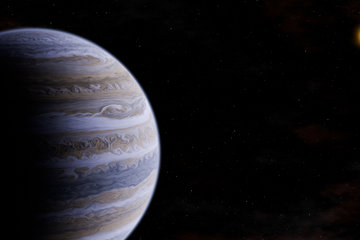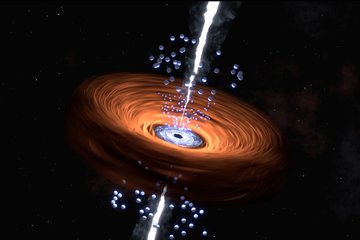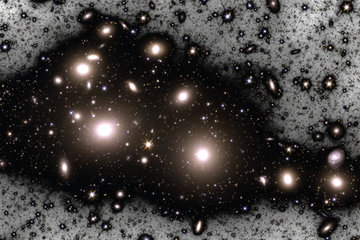The nebula with the dark band
The active galaxy Centaurus A has made history in radio astronomy
This is the closest the Event Horizon Telescope has ever come to the galaxy Centaurus A. The image shows the jet of matter blown into space by the central black hole in unprecedented detail. With this, the worldwide telescope network of eight individual observatories has added another chapter to the research history of this radio galaxy. Since its discovery in the mid-19th century, astronomers have carefully examined Centaurus A at all possible wavelengths. Since the late 1940s, the extraordinary galaxy has also been the subject of radio astronomy – a comparatively young discipline that has opened a new window on space.
Text: Helmut Hornung

It sometimes takes a little longer before a scientific method becomes standard and opens up new horizons for research. A prime example of this is radio astronomy. In the early 1930s, the physicist Karl Jansky, on behalf of the US Bell Telephone Laboratories in New Jersey, searched for unwanted noise in the transmission of radio broadcasts. Because the technology was still in its infancy, a disturbing crackling often sounded from the loudspeakers and interrupted the evening news or Louis Armstrong’s trumpet solos.
In the summer of 1931, with an approximately 30-metre-long monstrosity made of wood and wire, which resembled a high fence more than an antenna, Jansky listened into the ether. After only a short time, he located the source of the disturbance: thunderstorm. Jansky might have been satisfied – if there hadn’t been another strange, steady hiss, which seemed to emanate from a source that moved across the sky within one day at the speed of stars (i.e. in 23 hours, 56 minutes, and four seconds and thus exactly following the Earth’s rotation).
In the spring of 1933, it became clear to Jansky that this diffuse hissing could only have come from the depths of the universe. The major American newspapers reported the discovery. But the Great Depression preoccupied people much more than any signals from space. The physicist persisted and eventually succeeded. “Radiation is always received when the antenna is pointed at the galaxy”, he wrote in 1935. What was meant was the shimmering band that stretches across the heavens on a clear summer night. It is part of that island of worlds shaped like a slightly bent Frisbee and which is home to hundreds of billions of stars – including our sun with its eight planets.
By then, a new branch of science had developed: radio astronomy. But the community of researchers took no notice of this at first. Only one – Grote Reber – had carefully read Jansky’s publications and recognized the potential of the method. With a material cost of 2000 USD, the radio amateur built a nearly ten-metre, fully movable dish, placed it in the garden of his house in Wheaton, Illinois, and pointed it at the galaxy every free minute. For this, he did not have to wait for clear skies and was also able to carry out observations during the day. With this antenna, Reber scanned the heavens at various frequencies from 1937 onwards. In 1943, he published the data of a complete survey of the sky.

As Grote Reber listened to the sky with his oversized saucer, he wasn’t quite sure what he was actually hearing. Only after the Second World War did scientists gradually realize the possibilities offered by the radio window. Increasingly more researchers set about decoding the messages from the universe with their antennas. That’s when radio astronomy took off.
But what exactly is behind the invisible waves from outer space? Radio radiation is nothing more than a long-wave version of visible light. The spectrum for which the Earth’s atmosphere is permeable extends from sub-millimetre and millimetre waves beyond the infrared to waves that are centimetres to several metres in length.
In the cosmos, radio radiation comes from different sources. A basic distinction is made between two types: non-thermal radiation is produced by highly energetic electrons that travel at almost light speed on spiral paths around magnetic field lines; galaxies in particular emit this ‘synchrotron radiation’. Thermal radiation, on the other hand, arises from the intrinsic temperature of bodies (e.g. in hot gas nebulae).
If we had “radio eyes”, the earthly sky would look quite different. Stars would hardly be visible. But we would be able to see cosmic clouds and the remains of supernovae. The Milky Way would stand out as a bright band with many structures. One object above the plane of our galaxy would be particularly striking: Centaurus A.
In optical light, this galaxy some 13 million light years away in the constellation Centaurus has been known for a long time. Astronomer John Herschel discovered it while observing the southern sky from the Cape of Good Hope between 1834 and 1838. In his directory, published nine years after his return, he describes it as an unusual-looking nebula “cut by a broad, dark band”.
Under the designation NGC 5128, the object was included in the New General Catalogue of Nebulae and Clusters of Stars published at the end of the 19th century. It was not until the 1950s that, thanks to increasingly precise measurements, researchers discovered that NGC 5128 was a separate galaxy.
An article by the British-Australian astronomer John Gatenby Bolton with two co-authors had previously appeared in Nature in 1949. Shortly after the Second World War, this pioneer of radio astronomy and his team had begun to identify cosmic radio sources with known objects. For example, the group used a special telescope on the Australian coast to detect, among other things, the radio emission from NGC 5128: the sea cliff interferometer. This simultaneously registered two signals – the one emitted directly from the source in the sky and the one reflected from the surface of the Pacific. In this way, it was possible to simulate a virtual radio telescope (interferometer) several hundred metres in diameter.

This made it possible to identify previously known strong radio sources such as Centaurus A – but also Virgo A and Taurus A with their optical counterparts (i.e. with the galaxies NGC 5128, Messier 87 and the Crab Nebula, a supernova remnant). Bolton’s group reported these results in the Nature article mentioned above.
This work by the researchers was quite a remarkable feat because the resolution of a radio telescope is generally quite low. That is simply the nature of things: the longer the wavelength used for observation, the lower the resolving power. For example, a two-euro coin about 2 km away could still be seen with a small optical telescope with an aperture of 60 mm. If the coin were to emit radio radiation, an antenna almost 7 km in diameter would be needed to make the coin visible at a wavelength of 5 cm.
That’s why radio antennas are always quite large. And why when measuring, the interferometry method is used as in the sea cliff interferometer. The Event Horizon Telescope (EHT) also works on this principle – eight telescopes spread across the globe are connected. This makes the antennas act as one, with a diameter equal to the greatest distance between the observatories involved.
With the EHT, this results in a virtual antenna diameter of earth size. It receives radio radiation of 1.3 mm wavelength and has a resolving power of one 20 millionth of a second of arc. Theoretically, this would allow you (ignoring the curvature of the earth) to read a newspaper held by someone in New York from Munich.
The EHT produced the now iconic first image of the shadow of a black hole. This was first presented to the public on 10 April 2019. Data from the centre of the giant elliptical galaxy M 87 was recorded in 2017. At that time, the observation programme also included Centaurus A. The image now published shows the heart of the galaxy, where a black hole with 55 million solar masses lurks. From it emerges – as in most active galaxies – a jet of matter that extends symmetrically several hundred thousand light years into space.
This means that the exploration of this galaxy has reached a peak, at least for the time being. Because of its southern position, Centaurus A came into the focus of large optical telescopes relatively late because they were built in the Earth’s southern hemisphere only four decades ago. By contrast, in the 1960s, especially in Australia, powerful radio antennas were already listening to the sky.
Since then, Centaurus A has also been observed in this long-wave spectral range. Even though the researchers have discovered a great deal about Centaurus A – for example, that it probably collided with a small spiral galaxy a few hundred million years ago and completely absorbed it – there are still many secrets waiting to be revealed.














